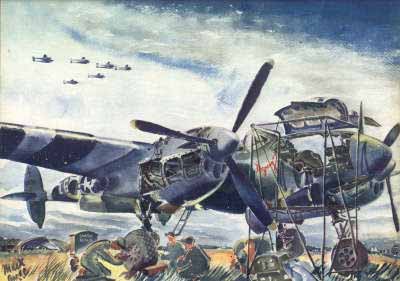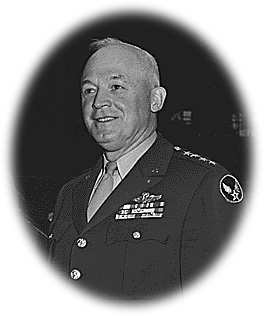
Through 1944 and 1945, the men of the 33rd Photo Reconnaissance Squadron carried out aircraft operations activities such as engine maintenance and camera repair in the open fields of England, France, Belgium, the Netherlands, and Germany.
Water color painted by Captain Milton N. Marx, A.C. Reproduction courtesy of Lou Cerino, 34th PRS via Rich Faulkner

"Our photo reconnaissance pilots were instructed to fly on the theory that fighter planes win battles while camera planes win wars."
General Henry H. "Hap" Arnold, US Army Air Forces
Photo courtesy of the Franklin D. Roosevelt Library Digital Archives

You can honor a member of the 33rd Photo Recon Squadron (or any other World War II veteran) at the National World War II Memorial. To find out how, click here.
They were the eyes of the greatest air armada of all time. Their weapons were speed, cunning, and a camera lens. Passing through flak and enemy fighters, their pilots found the targets. Then, after the bombs were dropped, they passed back through the hornet's nest to record what had been accomplished. All the while, their mechanics and technicians worked in the open air, exposed to extremes of heat and cold, rain and snow.They were the photo reconnaissance squadrons of World War II, and theirs may be the greatest war story never told. One of those squadrons was the 33rd Photographic Reconnaissance Squadron of the US Army's 9th Air Force:
Our P-38s carried no guns and very little armor for weight reduction to gain more speed in combat missions. These missions were as low as 25 feet, in some cases, to photograph a certain objective for study by upper echelon and field unit infantry commanders. These pilots were also called upon to fly in behind the bombers for bomb damage assessments. Our unit participated in the battles of Normandy, the Battle of the Bulge, and was one of the first Allied air units to operate on German soil, ending up at the Elbe River on VE Day. Our ground crews worked in mud, snow and ice to get their planes in the air, and our photography support units worked around the clock, in many instances, to retrieve and develop film in record time for use by infantry and armored combat commanders. Our pilots, like the rest of us at times, slept in tents, waded in snow, ice and mud, and when airborne often times froze from the minus 70 degrees Fahrenheit temperatures at very high altitude. At all times, these pilots were constantly watching and waiting for enemy fighters and flak. (Elwood Davis, 33rd PRS veteran, Air Classics, Volume 27, Number 8, August 1991, page 81)This website tells the tale of the dedicated men of this unit. They did their duty when their country needed them. It's our duty to remember them.
How This Website Works
Information on this website is divided into chapters that are equivalent to chapters in a book. You access the introductory pages for these chapters from the chapter drop-down list located in the upper left corner of every webpage of the 33rd PRS Online. For a quick overview of how to use the navigation features of this website to find data quickly and easily, take a few minutes to browse through the tips in the topic drop-down list below.
The 33rd PRS Online uses popup windows to present historical information only, and these windows only appear if you click a clearly marked link. We don't use popup windows for advertising. If you use popup window blocker software, it may keep the popup windows in this website from displaying. If you click a link, and nothing happens, we suggest that you disable your popup blocker software while visiting the 33rd PRS Online.
Can You Help Us?
We're always updating the 33rd PRS Online with new material donated by squadron veterans, their families, their friends, and interested third parties. If you have information to share about the 33rd PRS, such as photos, letters, and anecdotes, we need to hear from you.
Original materials are handled with utmost care and promptly returned. High quality scans and color photocopies are also welcome. All submissions and donations are fully credited when featured as part of this website. To find the email address for our webmaster, click here.
A Final Word Before You Go On
What was it like to serve in World War II? You'll find some answers to that in this website, but it might be helpful to remember this wartime observation by frontline correspondent Ernie Pyle:
Was war dramatic, or wasn't it? Certainly there were great tragedies, unbelievable heroism, even a constant undertone of comedy. But when I sat down to write, I saw instead: men at the front suffering and wishing they were somewhere else, men in routine jobs just behind the lines bellyaching because they couldn't get to the front, all of them desperately hungry for somebody to talk to besides themselves, no women to be heroes in front of, damned little wine to drink, precious little song, cold and fairly dirty, just toiling from day to day in a world full of insecurity, discomfort, homesickness, and a dulled sense of danger....I knew of only twice that the war would be romantic to the men: once when they could see the Statue of Liberty and again on their first day back in the home town with the folks. (Here is Your War, Ernie Pyle, Henry Holt and Company, New York, 1943, page 102)
Next time you see a World War II veteran, say thanks.
